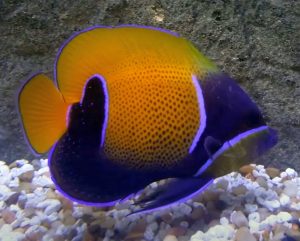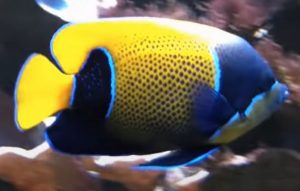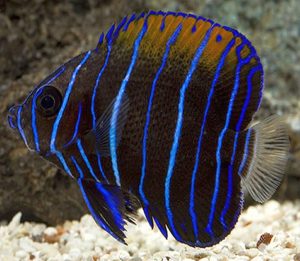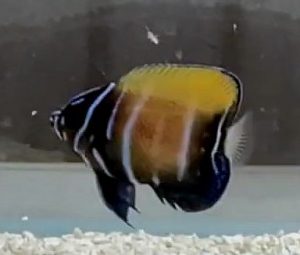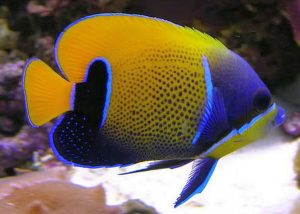The Majestic Angelfish (Pomacanthus Navarchus) known to tropical fish keeping enthusiasts as the Blue Girdled Angelfish is common along the coral reefs throughout the tropical waters of the Indo-Pacific.
The Majetic Angelfish‘s range extends from Indonesia and the Philippines to northern and eastern Australia and Micronesia .
Although juvenile Majestic Angelfish are often found in shallow coral rich habitats; adult specimens are normally collected along the outer reef slopes, channels, and coral rich lagoons as deep as 130 feet. Like many marine angelfish, Pomacanthus Navarchus are territorial and loners, however, they are occasionally found in small groups or in pairs in the demersal zone feeding on small invertebrates, algae, sponges, tunicates, and zooplankton.
Majestic Angelfish are distinctly colored with three main areas that are separated by pale blue bands edged in black.
The funnel shaped front section from just below the eyes to the rear of the pectoral fins and the gill plates is a dark blue. Just below the eyes to the rear of the pectoral fins is a lemon yellow color. The mid portion is a reticulated bright yellow with blue dots, and the posterior portion to the base of the caudal fin including the anal fin is deep blue with pale blue/white dots.
The dorsal and caudal fins are bright yellow rimmed with a pale blue border edged in black. The mouth, lips, and trailing rays of the pectoral and anal fins are blue as well.
Juveniles are colored a dark blue with curved bluish/white lateral stripes and clear caudal fins. As they mature, they
adopt the yellow coloration on the flanks, dorsal, and caudal fins.
Pomacanthus Navarchus are protandric hermaphrodites, that begin their adult lives as females and later change into a male.
Except for large angelfish and conspecifics, the Majestic Angel is shy and mellow by angelfish standards and can be peacefully housed with Clownfish, Tangs, Triggers, Wrasses and other semi-aggressive species. Yellow Tangs, Harlequin Tusks, Flame Angels and Blue Jaw Triggers are good options.
It’s best to add most or preferably all larger fish simultaneously to reduce territorial aggression.
If the aquarium is large enough, it is possible to house two Majestic Angelfish of the opposite sex in the same tank, however, there is no reliable way to sex them.
Majestic Angelfish are best housed in a large, stable, mature aquarium of at least 125 gallon capacity with plenty of live rock with algae and sponge growth for them to graze upon and arranged into overhangs, caves, and large crevices for them to hide amongst. Blue Girdled Angelfish are not considered to be reef safe and will nip at soft and stony polyp corals, sessile invertebrates, and clam mantles. They are less likely to consume SPS corals and some may ignore corals entirely.
When first introduced into the tank, Majestic Angelfish are rather shy but with a variety of food offerings will adapt quickly. They grow very slowly and max out in a tank at around 10″.
Like all marine angelfish, Pomacanthus Navarchus require pristine water quality and good reef lighting to flourish. A good wet dry reef filtration system with a reliable protein skimmer and regular water changes are necessary to maintain optimum water parameters.
15% bi-weekly or 30% monthly water changes should be considered routine. If there are corals in the tank, change 10% every 2 weeks or 20% every month.
They are intolerant of high nitrates or nitrites. Nitrites should be kept to 0 ppm while nitrates should be maintained at < 5 ppm.
In the wild they Majestic Angelfish (Pomacanthus Navarchus) will hybridize with the Bluefaced Angelfish or Yellowfaced Angelfish, Pomacanthus xanthometopon. As of this post, there have been no reports of Majestic Angelfish being successfully bred in an aquarium environment.
In the wild, Majestic Angelfish are omnivores that feed on a wide variety of sponges and tunicates. In an aquarium environment, they should be fed a variety of live, frozen, and prepared formula foods. Chopped scallops, squid, shrimp, vegetable based food preparations with marine sponges and tunicates should be fed three or more times a day. Offer finicky eaters gut loaded live brine shrimp, frozen Mysis Shrimp, clams, or red macro algae attached to a piece of live rock until they develop an appetite.
Many tropical fish keeping enthusiasts chop up shrimp, squid, mussels, spinach, etc. and freeze the concoction into small portions for marine angels.
Majestic Angelfish (Pomacanthus Navarchus) are available to tropical fish keeping enthusiasts from fish shops, importers, online auction sites, and a variety of online retail sources at modest prices, usually between $100.00 to $295.00 at approximate purchase sizes.
Juveniles: Small 1-1/4″ to 2″, Medium 2″ to 2-1/2″, Large 2-1/2″ to 3″
Sub Adult: Small 2″ to 2-1/2″, Medium 2-1/2″ to 3″ Large 3″ to 3-1/2″
Adult: Small 1.5″ to 2-3/4″; Small/Medium 2-3/4″ to 3-1/4″ Medium: 3-1/4″ to 4-1/4″; Large: 5-1/4″ to 6-1/4″ X Large 6-1/4″ to 7-1/2″
Minimum Tank Size: 125 gallons
Aquarium Type: Deepwater Reef
Care Level: Difficult
Temperament: Semi Aggressive
Aquarium Hardiness: Moderately Hardy when acclimated
Water Conditions: 74-78°F, dKH 8 to 11.5, pH 8.1-8.4, sg 1.023-1.025
Max. Size: 10″
Color Form: Black, Yellow, Blue
Diet: Omnivore
Compatibility: Not Reef Compatible
Origin: Indo-Pacific Ocean
Family: Pomacanthidae
Lifespan: Up to 21 years
Aquarist Experience Level: Advanced


